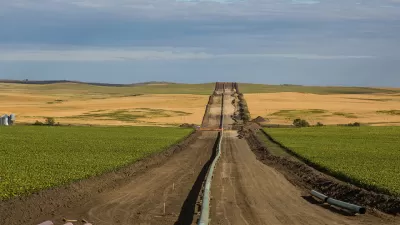Comparisons to Wounded Knee have been common as a growing number of Native Americans are gathering in North Dakota to protest the construction of a new crude oil pipeline.

William Yardley reports from the scene of a growing protest against the proposed Dakota Access oil pipeline, which would "carry more than 400,000 barrels of crude oil a day from the Bakken region of western North Dakota across South Dakota and Iowa to connect with an existing pipeline in Illinois."
"The 1,100-mile pipeline, which is estimated to cost $3.7 billion, is nearly halfway complete," adds Yardley. "But construction on a section that would sink beneath the Missouri River, just north of the reservation of the Standing Rock Sioux, has been halted under orders from the sheriff of Morton County, Kyle Kirchmeier."
The sheriff ordered the halt in response to a growing number of Native Americans, gathering to protest the construction. "What began with a handful of natives establishing a prayer camp along the river this spring has now drawn international environmental groups and prompted Hollywood celebrities, including Susan Sarandon and Shailene Woodley, to join them, whether here or in a protest last week in Washington, D.C., or on social media."
The article goes on to detailing the work of Earthjustice to build a legal case against the project, and the rulings from the United States District Court that could impact the project. Judge James A. Boasberg has promised a ruling no later than September 9 on a request to stop construction. The article also includes personal stories from some of the Native Americans protesting the project.
FULL STORY: With echoes of Wounded Knee, tribes mount prairie occupation to block North Dakota pipeline

Planetizen Federal Action Tracker
A weekly monitor of how Trump’s orders and actions are impacting planners and planning in America.

Congressman Proposes Bill to Rename DC Metro “Trump Train”
The Make Autorail Great Again Act would withhold federal funding to the system until the Washington Metropolitan Area Transit Authority (WMATA), rebrands as the Washington Metropolitan Authority for Greater Access (WMAGA).

The Simple Legislative Tool Transforming Vacant Downtowns
In California, Michigan and Georgia, an easy win is bringing dollars — and delight — back to city centers.

The States Losing Rural Delivery Rooms at an Alarming Pace
In some states, as few as 9% of rural hospitals still deliver babies. As a result, rising pre-term births, no adequate pre-term care and harrowing close calls are a growing reality.

The Small South Asian Republic Going all in on EVs
Thanks to one simple policy change less than five years ago, 65% of new cars in this Himalayan country are now electric.

DC Backpedals on Bike Lane Protection, Swaps Barriers for Paint
Citing aesthetic concerns, the city is removing the concrete barriers and flexposts that once separated Arizona Avenue cyclists from motor vehicles.
Urban Design for Planners 1: Software Tools
This six-course series explores essential urban design concepts using open source software and equips planners with the tools they need to participate fully in the urban design process.
Planning for Universal Design
Learn the tools for implementing Universal Design in planning regulations.
Smith Gee Studio
City of Charlotte
City of Camden Redevelopment Agency
City of Astoria
Transportation Research & Education Center (TREC) at Portland State University
US High Speed Rail Association
City of Camden Redevelopment Agency
Municipality of Princeton (NJ)



























